 Each child grows and develops at his or her own rate. Children display developmental landmarks at different times. This guide presents characteristics that children between the ages of 6 and 11 will typically display as they grow and develop.
Each child grows and develops at his or her own rate. Children display developmental landmarks at different times. This guide presents characteristics that children between the ages of 6 and 11 will typically display as they grow and develop.
The school-age years (ages 6 through 11) bring new and exciting challenges and rewards for children. Using the initiative they established as preschoolers, the primary job of the school-age child is to develop a sense of personal competence. This means that children establish a sense of self or self-concept based on their abilities. This self-concept is influenced by how easily they learn new skills. Children use feedback from important adults, peers and their own self-evaluation to judge their competencies.
School-age children's style of thinking is concrete, meaning that their thinking and reasoning is more logical and organized than it was during the preschool years. For example, school-aged children can classify objects in different ways (such as sorting baseball cards by team, playing position, league, etc.). Furthermore, children are able to understand and express a variety of emotions. Friendships among school-age children blossom, as they become better able to take the perspective of others.
Adults play an important role in helping school-age children develop a sense of personal competence. You can contribute to a child's sense of self and help foster his or her self-esteem by:
- Offering praise and reinforcement.
- Helping a child to recognize his or her own unique talents and abilities.
 Furthermore, you can enhance a child's social and emotional development by encouraging your child to talk about his or her feelings and helping him or her develop problem-solving skills to use in friendships and other peer relationships. This guide offers general knowledge about children's development during the school-age years, including
Furthermore, you can enhance a child's social and emotional development by encouraging your child to talk about his or her feelings and helping him or her develop problem-solving skills to use in friendships and other peer relationships. This guide offers general knowledge about children's development during the school-age years, including
- Thinking and learning
- Awareness of self and others
- Communication
Suggestions for how you can foster children's positive development are offered. Additionally, special attention is paid to several issues important during the school-age years, including personal physical fitness and peer relationships.
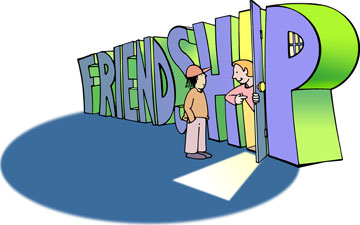
Relationships with peers
When most of us look back on our childhoods, we can recall a particular close friend or a group of classmates or other peers who were important to us. In fact, research on school-aged children shows that having positive peer relationships is related to many other aspects of positive adjustment. Children who have good relationships with classmates are less lonely, less depressed, miss fewer days of school, and report enjoying school more.
For these reasons, it makes sense that parents and teachers worry about children who have more problematic relationships with peers. It is important to keep in mind, though, that a child does not have to be the most popular kid in class to have good relationships with peers. In fact, peer relationship researchers have identified two major areas in which children can be successful in peer relationships:
- Peer acceptance, or being generally well-liked by classmates;
- Reciprocal friendship, or children having a relationship with at least one classmate, in which both children consider the other a friend.
Although it is wonderful for children to both be well-accepted and to have a reciprocal friend, most children who are either well-accepted or have a reciprocal friend would be considered relatively successful in their peer relationships. For example, a child may be well-liked by most of his or her classmates but not have found one classmate in particular with whom he or she has formed a close one-on-one relationship. Perhaps more importantly, a child who is having a tough time with his or her classmates in general can really benefit from having at least one close friend.
Sadly, some children are both not well-accepted by classmates in general and lack a close friendship. But there are ways that parents and teachers can help:
 Help teach good social skills. Complement the child when he or she behaves in a friendly manner and explain to him or her why behaving that way is important.
Help teach good social skills. Complement the child when he or she behaves in a friendly manner and explain to him or her why behaving that way is important.- Model friendly behavior yourself by allowing the child to see your own friendly behavior with others. Explain why you behave that way.
- Serve as an agent for the child's peer relationships. Parents can invite a classmate over to play. Teachers can group children together for activities. It is important to choose a peer who you think would be receptive to friendly overtures from the child.
Parents and teachers should never underestimate the importance of children's relationships with peers. Through making and managing friendships, children are learning to build close, satisfying relationships with others who are not members of their own family. These are important skills that will serve them well for many years to come.
We extend our appreciation to Amanda J. Rose, assistant professor of psychological sciences at MU, for her expertise on peer relationships.
Physical activity
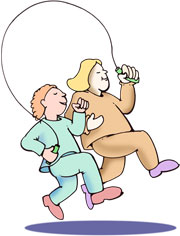 Between the ages of 6 and 11, children experience many physical changes. Children's arm and leg coordination increases, their ability to use their fingers and hands for crafts and writing improves, and their interest in games with rules and organized sports grows. Unfortunately, many of today's youths do not get enough exercise.
Between the ages of 6 and 11, children experience many physical changes. Children's arm and leg coordination increases, their ability to use their fingers and hands for crafts and writing improves, and their interest in games with rules and organized sports grows. Unfortunately, many of today's youths do not get enough exercise.
Did you know?
- Nine out of 10 parents believe their children are physically fit, but in reality only one in three children are.
- 63 percent of children are physically inactive by the time they are in high school.
- 20 percent of the average child's waking hours are spent watching television.
- Children who are physically active experience fewer chronic health problems than sedentary children.
- Physically active children have higher self-confidence and better self-images.
Parents, teachers and fitness professionals play important roles in promoting physical fitness among children. However, the parents' role is the most important. Children model their parents' behavior, so parents must be physically active too.
So, what can parents do to promote physical activity among their children?
- Plan family exercise activities so that parents and children can exercise together and have fun! For example:
- Take walks (in the mall, at the zoo, with the family pet)
- Go on bike rides and nature hikes
- Run races
- Jump rope
- Play games
- Go swimming in the summer and sledding in the winter
- Create an obstacle course
- Make sure family activities are fun, not overly competitive. Give children lots of praise and reinforcement. 4 Let children help plan family activities. They will feel more invested in the activity and will likely enjoy it more. When physical activity is fun, children are more likely to become active and stay active.
- Be sure that fitness activities include time for stretching, as children's bones and muscles are still developing during the elementary school years.
- Always remember to take safety precautions such as wearing a helmet when biking and putting on sunscreen when swimming in the summer sun.
- If television viewing is a concern, try this simple equation, where children earn their television time:
- 1 hour of reading/studying = 1/2 hour TV
- 1 hour of active play = 1/2 hour TV
Have fun, and get fit as a family
Developmental landmarks
Thinking and learning
Characteristics
- Uses logic and strategy for problem-solving
- Able to sequence things, see patterns, and "think in reverse"
- Understands "cause and effect" more accurately
- Memory improves dramatically
- Uses more than one characteristic to classify things
- Better able to pay attention, plan ahead, and avoid distractions
- Learning experiences become more integrated; knowledge and skills from one area are used in other areas
- Engages in "metacognition": think about thinking, think about reasoning, and think about memory
- Reading skills continue to develop and improve
- Reading, writing, and computer skills are influenced by sense of personal competence
- Learning is enhanced by self-evaluation and self-management skills
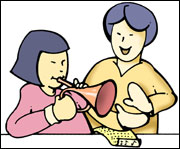 What can adults do?
What can adults do?
- Create opportunities for children to make choices and ask them to explain their reasons.
- Encourage children to think about how things relate to each other (e.g., "If I practice the flute every afternoon, I'll be a better musician.").
- Ask children open-ended questions.
- Play memory games with children.
- Play more complex and thought-provoking games with children (e.g., Clue, Risk, Mono-poly).
- Engage children in conversations about thinking and how to think well (e.g., "If I do this...what might follow?").
- Read with children daily, encouraging children to read to you; build up to private reading time.
- Go to the library. Let your child get his/her own library card. Introduce children to the many kinds of books — fiction, non-fiction, books about hobbies, history, sports, animals, poetry, feelings, chapter books, cookbooks, etc.
- Provide children musical learning opportunities; let children invent their own music, make musical instruments, create dances, and make up musical games.
- Help children learn about time management; keep a family calendar of activities and special events.
Awareness of self and others
Characteristics
- Able to remember rules and standards; do not need adult reminders all of the time
- Able to observe and evaluate own behavior; conscience develops
- Children are "rule-governed": fairness is important, and the world is "black and white," "right or wrong," "good or bad"; do not yet see how one situation may be interpreted in many ways
- Understands competition and competitiveness emerges
- Self-concept is linked to the development and successful acquisition of new skills
- Able to judge own skills and abilities
- Also relies on feedback from important others about skills and abilities
- Bases self-esteem on sense of self in academic role, social relationships, and physical competence
- Quest for competence inspired by desire to perform well, master new skills, and please adults
- Sensitive about being compared to peers
- Prefers same gender playmates; gender identification is strong
- Reciprocal friendships characterized by shared interests, mutual assistance, loyalty, and trust
- Understands that others may have thoughts and preferences that are different from their own
- Still relies on adults for guidance in some social situations
- Benefits from chores (family and personal chores)
- Developing a concept of self as a worker, and wants to earn money
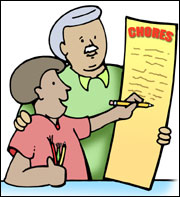 What can adults do?
What can adults do?
- Involve children in establishing rules.
- When children misbehave, help them understand the rules and the reason for the rules.
- Allow children to try a variety of team and competitive sports.
- Encourage children to set high but achievable goals for themselves.
- Celebrate children's accomplishments, and help them learn from criticism (e.g., "How can you do it differently next time?").
- Encourage a positive sense of self through reinforcement and praise.
- Help children recognize their special skills and talents.
- Keep track of your children's friends; get to know them and their families.
- If children have a hard time getting along with their peers, help them develop the necessary social skills so they can establish positive peer relationships (e.g., role play).
- When children have conflicts with their friends, role play with them about how they might manage the problem.
- Set regular, realistic chores for children. Have children create charts to check off chores as they are completed.
- Help children plan how to use their allowances; encourage good saving habits.
Communication
Characteristics
- Speaks in full sentences and asks many questions
- Able to relate past experiences in vivid detail
- Seeks information and justification for the "way things are"
- Understands and talks about others' perspectives
- Recognizes the influence their own behavior can have on others
- Uses language to include or exclude others from social group
- Can manage multiple pieces of information at one time
- Able to verbally solve problems and set goals with adult assistance
- Talks more with peers and friends
- Writing skills continue to improve
- Loves riddles, jokes, tongue twisters and puns
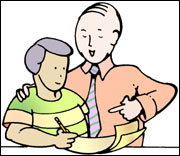 What can adults do?
What can adults do?
- Provide numerous opportunities for children to spend time with friends and talk one-on-one with adults.
- Ask children to talk about their experiences with school, friends, and other activities.
- Encourage children to articulate their likes and dislikes and to provide explanations.
- Engage in "emotion coaching" to help children better understand their feelings.
- Create opportunities for verbal problem-solving and take the time to help children develop problem-solving skills.
- Assist children in writing personal letters and stories about their experiences or fantasies; introduce children to drama and playwriting.
References
- The Friendship Factor: Helping Our Children Navigate their Social World — And Why it Matters To Their Success and Happiness, by Kenneth H. Rubin and Andrea Thompson. Viking Press, 2002.
- Raising an Emotionally Intelligent Child, by John M. Gottman, Joan Declaire, and Daniel P. Goleman. Fireside, 1996.
Note
Visit MU Extension's MissouriFamilies.org for additional information about adolescents, aging, child care, consumer action, divorce, food safety, health, housing, nutrition and fitness, parenting, and personal finance.